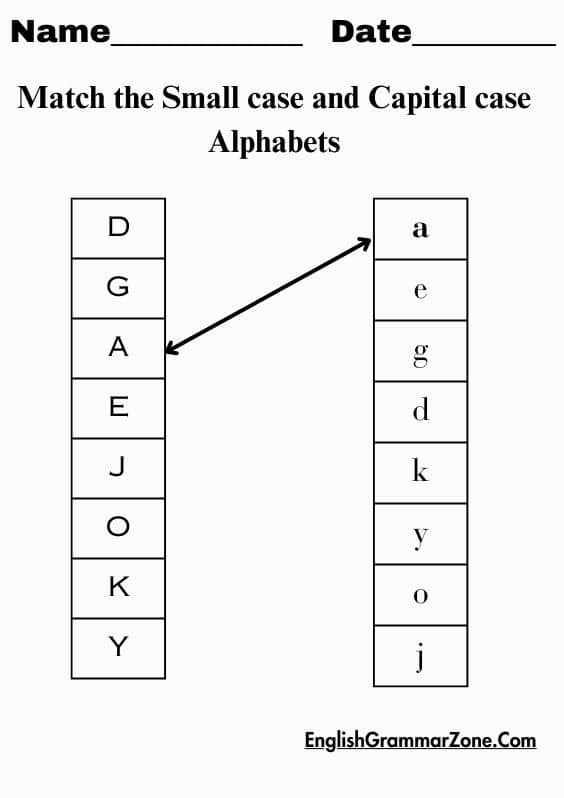Matching Upper Case and Lower Case Letters: Learning the difference between upper case and lower case letters is a fundamental step in understanding the structure of written language. It’s a skill often taught in early education but continues to be useful throughout life, especially in tasks like typing, coding, and proofreading. Matching upper case and lower case letters can improve reading comprehension, spelling, and written communication. This article will help you explore why this skill is important, how to practice it effectively, and answer common questions about upper and lower case letters.
Match the small case and capital case alphabets
Worksheet -01

Frequently Asked Questions About Matching Upper Case and Lower Case Letters
What Are Upper Case and Lower Case Letters?
Upper case letters, also known as capital letters, are the larger forms of the alphabet used at the beginning of sentences and proper nouns. Lower case letters are their smaller counterparts, used in most other contexts. For example, in the word “Apple,” the “A” is upper case, and “pple” is lower case.
Why Is Matching Upper Case and Lower Case Letters Important?
Matching upper and lower case letters is essential for:
- Improved Reading Skills: Recognizing the relationship between upper and lower case forms helps children learn to read faster.
- Better Writing Skills: Writing correctly with proper capitalization ensures your message is clear and professional.
- Avoiding Errors: In digital communication or coding, incorrect matching can lead to errors, such as in passwords or programming commands.
How Can I Teach Matching Upper Case and Lower Case Letters to Children?
To teach children this skill:
- Use flashcards showing both cases of a letter side by side.
- Play matching games where kids connect the upper case with its lower case counterpart.
- Practice through writing exercises that involve copying sentences with mixed-case letters.
- Use educational apps and games designed to reinforce letter recognition.
What Are Some Activities for Practicing Upper and Lower Case Matching?
Here are some engaging activities for practicing this skill:
- Letter Sorting: Give students mixed letters and ask them to sort upper case and lower case separately.
- Matching Games: Create cards with upper case on one set and lower case on another. Let children find the matching pairs.
- Tracing Worksheets: Provide worksheets with upper and lower case letters for tracing to reinforce memory.
- Online Tools: Use free online platforms with interactive games focused on case matching.
What Are Common Mistakes When Learning Matching Upper and Lower Case Letters?
Some common errors include:
- Confusing letters that look similar in both cases, such as “C” and “c” or “P” and “p.”
- Forgetting that certain letters, like “i” and “j,” have different features in upper and lower case forms (e.g., a dot on the lower case).
- Skipping practice with rarely used letters, such as “Q” and “q.”
How Can Adults Improve Their Skills in Matching Upper Case and Lower Case Letters?
Even adults may need to sharpen their skills, especially in professional writing or learning new languages. Here’s how:
- Use text-based games like Scrabble or word puzzles.
- Proofread your written work carefully, paying attention to capitalization rules.
- Practice typing with a focus on correctly capitalizing names, titles, and acronyms.
- Refresh your memory of grammar rules by reading style guides or grammar books.
Does Matching Upper and Lower Case Letters Help in Digital Communication?
Yes, matching upper and lower case letters correctly is crucial in the digital world. For example:
- Passwords: Many passwords are case-sensitive, requiring exact matching of upper and lower case.
- Usernames and Email Addresses: While usernames and emails are often case-insensitive, ensuring correct capitalization improves readability.
- Programming: Coding languages require precise matching of cases, as commands and variables are case-sensitive.
What Are the Rules for Using Upper and Lower Case Letters in English?
Here are some basic rules:
- Start of a Sentence: Always capitalize the first word.
- Proper Nouns: Use upper case for names of people, places, and organizations (e.g., “John,” “Paris,” “Google”).
- Titles: Capitalize the first and important words in titles, such as “The Great Gatsby.”
- Acronyms and Initialisms: Use all upper case (e.g., “NASA,” “FBI”).

